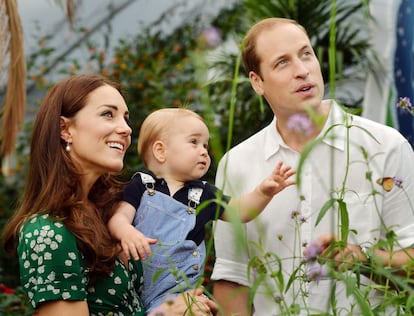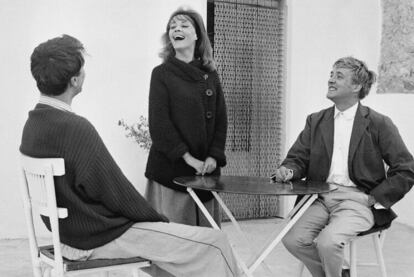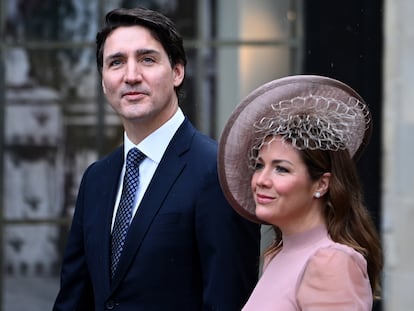From socioeconomic status to the number of ex-partners: what makes a lasting romance?
Without the help of artificial intelligence or ‘First Dates,’ having a successful relationship is still possible if you pay attention to the research

“Lighthouse couples” exist. Everyone knows one: hopeful examples that perfect love is possible and that not all relationships end (about four years later) in a painful separation. Rosalía and Rauw Alejandro were a lighthouse couple until a week ago. When news of their breakup became official, it left millions of people bereft of a romantic archetype to aspire to. To help you avoid getting into a bad relationship in the first place, we have prepared a short list of factors, based on the opinion of specialists and scientific studies, that positively influence the health and longevity of a romantic relationship.
1. Age difference: little to none
There are two unavoidable clichés when talking about age difference in love. The first is the saying: “Love is blind and does not see age.” The second is the pseudo-empirical rule (of unknown origin) that suggests the limit should be seven years. But science, going against incontestable truths (as it often does), has refuted these two historically held beliefs. The statistics don’t lie: age does matter when choosing a partner and the ideal age difference is, in fact, much less than seven years.
Emory University (Atlanta) conducted an analysis of more than 3,000 couples in order to better understand how age difference can affect the stability of a relationship. The results of this research revealed that couples with an age difference of one year are 3% more likely to separate than those of the same age. The percentage reached 18% when the difference rose to 5 years, and 39% when it reached 10 years of difference. In bigger age gaps (20 or 30 years) the chances of divorce reached 95%.

Couples psychologist Paloma Rey explains that people with less of an age difference tend to share more life experiences, cultural references and stages of personal development. “All of this fosters deeper emotional bonds and shared goals, which, in turn, acts as a protective factor within the relationship by making it more resilient to conflict and differences over time.” On the other hand, Javier Ares Arranz, a therapist who specializes in relationships, says that in these cases understanding and validating the perspective of your partner is fundamental. “If one partner is significantly older, they may have concerns about their health or how society may perceive their relationship. If these concerns are discussed openly, the couple can work together to find solutions that are acceptable to both parties.”
Although statistics indicate otherwise, there are always famous cases that buck the trend. For example, the legendary Hollywood couple Humphrey Bogart and Lauren Bacall had an age difference of more than 25 years. They met during the filming of To Have and to Have Not (1944), when Bogart was 45 and Bacall was just 19. An even more controversial case is that of Woody Allen and Soon-Yi Previn, who was the adopted daughter of Allen’s partner (Mia Farrow) when they met. Their age gap is around 35 years. And let’s not forget French President Emmanuel Macron and his wife Brigitte, who have been together for 24 years, and met when the leader was still in high school.
2. Opposites neither attract nor make good matches
To be lucky in love, the ideal is to look for someone who is the same. Several psychological and sociological investigations have refuted the commonly accepted idea that opposites attract, which tends to work more in romantic fiction than in real life. In fact, couples who share similarities in several areas tend to have healthier and longer-lasting relationships.
Taken to a somewhat frivolous extreme: a 2008 study concluded that having a similar physical appearance is a determining factor for an initial physical attraction, and to maintain long-term physical connection. Another 2010 study found that long-term couples tended to be similar in physical attractiveness.

This point covers many other aspects. For example, a 2014 study published by the National Bureau of Economic Research (NBER) looked at the effect of “selective mating,” that is, the tendency to seek partners similar to oneself in terms of education and socioeconomic status. The authors found that socioeconomic homogamy (couples who are similar in terms of education and socioeconomic status) is associated with greater stability in relationships and lower divorce rates.
Another study published in 2013 concluded that couples who met online (where it is easier to select someone based on specific characteristics such as socioeconomic status) had significantly lower divorce rates and reported a higher level of marital satisfaction.
Is this scientific evidence the reason why people tend to pair up with people of the same socioeconomic status and why celebrities only date other celebrities? Perhaps, but there are also a good number of examples of celebrities who have or have had lasting relationships with non-celebrities, such as actresses Maisie Williams, Julia Roberts, Anne Hathaway and Reese Witherspoon, or actors Aaron Paul, Matt Damon, Eddie Redmayne and Ethan Hawke. A royal example is the UK’s Prince William, who met Kate Middleton at the University of Saint Andrews in 2001.
3. Coming from a stable and loving family
Sigmund Freud said: “A man who has been his mother’s undisputed favorite keeps for life the feeling of a conqueror.” This insensitive quote toward those who have not experienced maternal love is complemented by a study supporting the idea that our early family experiences can affect our health and the quality of our romantic relationships into adulthood.
The researchers chose 60 babies and assessed their level of “secure attachment.” There is a psychological theory that identifies several types of attachment, the main ones being: secure, avoidant, ambivalent and disorganized. Each style has specific characteristics and behavior patterns that influence relationships throughout life. Secure attachment is a style in which a person feels comfortable and secure seeking emotional support and closeness with their caregivers.
The scientists assessed the babies’ attachment level by looking at how they interacted with their caregivers in a controlled situation. 20 years later, they measured their attachment level again through an interview. They found that approximately 72% of participants maintained the same secure or insecure attachment classification in early adulthood, compared to their attachment ratings in childhood. This means that early attachment experiences in childhood tended to influence how they related to others as young adults.
Paloma Rey argues that “if we have grown up in an unstructured family environment, with absent or negligent authority figures in caring for our needs, we are likely to develop an anxious, avoidant or disorganized attachment.” This favors the formation of unstable and unbalanced relationships. In contrast, “if our referents have maintained a relationship based on trust, assertive communication, respect and mutual affection, we are likely to develop a secure attachment.”
4. Having been friends before becoming a couple
Most romantic relationships originate in friendships. According to a study by the University of Victoria in Canada, 66% of couples were formed from a friendship. Last year, Joe Pinsker, a journalist with The Atlantic, set out the advantages of starting a romantic relationship with a friend. To back up his view, he cited Jessica Cameron, a professor of psychology at the University of Manitoba, who has been researching the transition from “friends to lovers.” Cameron suspects that couples who start out as friends tend to have happier and stronger relationships on average, and in fact, she is currently designing a research project to confirm this hypothesis.
Javier Ares Arranz argues that starting a romantic relationship from a friendship has its own pros and cons: “Starting as friends provides a solid foundation for a romantic relationship. When they know each other well, they can deeply understand each other’s strengths, weaknesses, values, and life goals.” However, there are also challenges in this transition: “One of the most common is the concern about putting existing friendship at risk. If the romantic relationship doesn’t work, it could affect or even end the friendship. It is important to address these concerns openly and honestly.”
5. Having had few relationships and few previous sexual experiences
This is one of the most controversial points. “You’ve been with few women; I’ve been with many men. The average is balanced, we could make an honest couple,” says the character of Jeanne Moreau in the film Jules et Jim (1962) when the men propose marriage. However, as the outcome of the film and various studies reveal, things do not always work that way.

Several studies have explored the relationship between the number of sexual partners and marital satisfaction. In their analysis, the researchers found that people who had had more sexual partners before marriage claimed to have lower satisfaction with their marital relationship. However, the researchers also cautioned that this effect was moderated by including variables such as religion and attitude toward casual sex. For example, in people with strong religious beliefs or not overly enthusiastic about casual sex, the effect of the number of sexual partners on marital satisfaction might be less pronounced. The study also concluded that people who had had more sexual partners were less likely to marry, and even that people who came to marriage as virgins had a much lower divorce rate.
Love evolves and changes over time, and the length of a relationship does not necessarily reflect the actual affection between the people involved. Marriage, at a time when divorce was not allowed and a partner was not allowed to choose, could last a lifetime, but it did not necessarily equate to successful or sincere love. Lasting relationships? They are very good, but satisfactory relationships are better. Even if it is not death that causes them to part.
Sign up for our weekly newsletter to get more English-language news coverage from EL PAÍS USA Edition
Tu suscripción se está usando en otro dispositivo
¿Quieres añadir otro usuario a tu suscripción?
Si continúas leyendo en este dispositivo, no se podrá leer en el otro.
FlechaTu suscripción se está usando en otro dispositivo y solo puedes acceder a EL PAÍS desde un dispositivo a la vez.
Si quieres compartir tu cuenta, cambia tu suscripción a la modalidad Premium, así podrás añadir otro usuario. Cada uno accederá con su propia cuenta de email, lo que os permitirá personalizar vuestra experiencia en EL PAÍS.
¿Tienes una suscripción de empresa? Accede aquí para contratar más cuentas.
En el caso de no saber quién está usando tu cuenta, te recomendamos cambiar tu contraseña aquí.
Si decides continuar compartiendo tu cuenta, este mensaje se mostrará en tu dispositivo y en el de la otra persona que está usando tu cuenta de forma indefinida, afectando a tu experiencia de lectura. Puedes consultar aquí los términos y condiciones de la suscripción digital.
More information
Archived In
Últimas noticias
Rowan Atkinson tops Netflix at 70: ‘He’s as funny as ever’
Israeli recognition of Somaliland stirs up the Gulf
Tiger Woods turns 50: Will he continue playing on the PGA Tour or take a back seat?
The surreal journey of James Nnaji, the Barcelona youth player selected in the NBA Draft who ended up in the NCAA
Most viewed
- Oona Chaplin: ‘I told James Cameron that I was living in a treehouse and starting a permaculture project with a friend’
- Reinhard Genzel, Nobel laureate in physics: ‘One-minute videos will never give you the truth’
- Sinaloa Cartel war is taking its toll on Los Chapitos
- Why the price of coffee has skyrocketed: from Brazilian plantations to specialty coffee houses
- Chevy Chase, the beloved comedian who was a monster off camera: ‘Not everyone hated him, just the people who’ve worked with him’











































